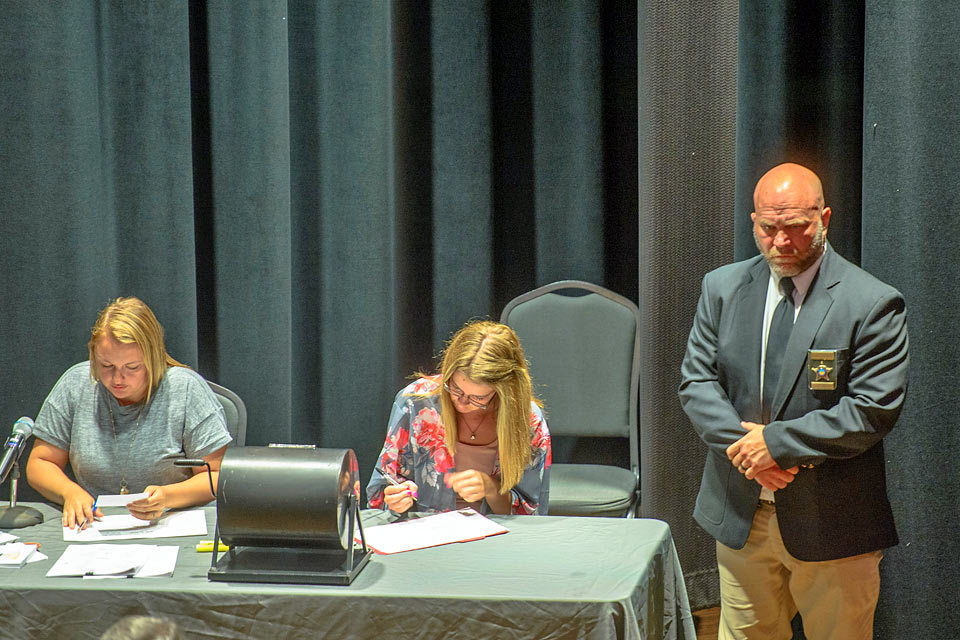During the “voir dire” or jury selction process, court employees from left, Shelbi Robbins, Britney McNamara and court bailiff David Lashley would call for potential jurors from the stage of the Memorial Theater. The potential jurors would take questions from the judge and attorneys on the stage.
MOUNT VERNON — During jury selection for the Paul Swanson trial, Common Pleas Court Judge Richard Wetzel looked up to the balcony.
The pool of potential jurors was below it, in the much-darker setting of the auditorium. Wetzel, along with the prosecution, Swanson and his attorney, were on stage, under the spotlights.
It was kind of hard to make out the juror’s faces in the contrasting lighting. But the light in the balcony made the seats much more distinct, and Wetzel wonders if the jury pool should sit there for the next trial.
Swanson’s trial was the first to be held in the Memorial Theater, which was selected as an alternative site for trials during the COVID-19 epidemic. The auditorium seats 993 — 834 auditorium seats and 162 in the balcony — and is large enough to allow for 6 feet social distancing of the jury pool, which can number between 50 - 60 people. The spacious ballroom on the third floor was dedicated as a courtroom, where the actual trial was held.
Swanson’s trial lasted two days. The former Mount Vernon Nazarene University volleyball coach was found guilty of gross sexual imposition, a charge that stems from his using the hand of an elderly woman with dementia to pleasure himself at a Mount Vernon rest home.
The ballroom of the Memorial Theater has been transformed into a courtroom as the legal system adjusts jury trials to COVID-19 restrictions. The large room will allow jurors, court officials and defendants to socially distance.
In coming to that verdict, however, the jurors had to overcome issues with the ballroom’s acoustics. A juror who sat through the first day was excused after confessing that he couldn’t make out half of what was being said by the witnesses and attorneys. It got to the point that he felt he could not decide the case because of everything he’d missed.
The jurors weren’t the only ones who had trouble hearing. The witness stand was set up facing away from the court reporter, with witnesses sitting in profile to the jury.
When the first witness, Mount Vernon Police Officer Austin Johnson, took the stand, the court reporter making a record of the proceedings couldn’t make out everything he said. The stand was repositioned so that witnesses now faced in the direction of the court reporter; the attorney’s podium — actually an event stand used for the ballroom’s more festive occasions — was also moved so that they spoke across the room.
As each witness took the stand, Wetzel asked them to speak clearly and slowly, in sentences rather than paragraphs. It kept the testimony from getting lost in the echo of the ballroom.
The evidence included an interview with Swanson and Mount Vernon Police Det. J.T. DeChant. It was played in its entirety for the jury, a half-hour of an important part of the state’s case. It was a lost half-hour; the jury couldn’t make out what was being said in the recording. It was provided for them to watch on a laptop while they were in deliberations.
For all its issues, the setting of the theater may have added to the juror’s experience, Wetzel said.
“This is a much more comfortable setting. Our courtroom, it’s not that it’s small, but it is a little intense,” Wetzel said. “This gives (jury selection) a nice, comfortable feeling.”
The Memorial Theater could see its share of trials over the next few months. At least three cases on the Common Pleas Court docket are expected to go to trial soon, Knox County Prosecuting Attorney Chip McConville said.


